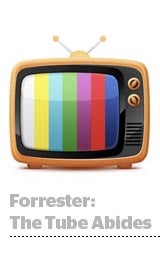 Despite the ballyhoo over cord cutting, data from Forrester Research shows there’s no widespread move by consumers to cut television services in favor of Internet streaming, at least for now.
Despite the ballyhoo over cord cutting, data from Forrester Research shows there’s no widespread move by consumers to cut television services in favor of Internet streaming, at least for now.
The reprieve is certainly good news for broadcasters, and also gives marketers some breathing room to straighten out their digital video strategies.
Forrester’s report showed that marketers’ fears of consumers migrating en masse to television consumption solely via the Internet are “overblown.” In the report, Jim Nail, a principal analyst serving marketing professionals, predicted only a modest decline over the next five years in the percentage of households with pay-TV service, from 82% in 2013 to 79% in 2018.
“Given the amount of talk and ink around cord cutting, it’s surprising to see how little of it is actually happening,” Nail said. “Most people don’t want to work that hard for TV. They want to come in, flip it on and veg out. Having to say, ‘Let’s see, is this on Netflix? No? Well maybe it’s on Amazon. No? Let me try Hulu, then.’ It’s just way too hard.”
While much of today’s content is available via live streaming, it mostly supplements existing subscriber services. Online streams of the ongoing Winter Olympics, for instance, are only offered to current cable subscribers. HBO’s streaming portal HBO GO is also available only to cable subscribers.
Nail’s predictions are largely substantiated by industry statistics. Last week, Time Warner Cable reported that it only lost about 800,000 subscribers out of 12 million over the course of 2013. And Comcast reports that over the past five years, it has lost about 2.5 million customers, maintaining about 21.7 million subscribers at this point.
And, as Nail points out in his report, many of those losses are attributable largely to service switching rather than cord cutting, with the advent of greater satellite penetration and increased TV service bundling by telecommunication providers.
“There is much more time [for marketers] to get used to this and get used to using digital views as a part of [their] marketing plan,” Nail said. “It’s not a situation where we’re going to wake up one morning and oh my God, nobody’s got a cable subscription anymore, and now we’ve got to figure it out.”
At the same time, advertisers can’t sit tight with stagnant strategies. There are still plenty of pressing challenges of fragmentation due to that increased prevalence of supplemental streaming consumption.
“We will still continue to see growth in watching streaming prime time kind of programming, because that’s still being driven by the desire to watch what you want, when you want,” Nail said. “So marketers should still try to understand how to use those different platforms and tie them into a coherent strategy. And once they figure that out, then if people start cutting the cord it kind of doesn’t matter.” He added most marketers are still far behind consumers with their strategies, often by about two years in innovation.
Nail also said the whole planning and buying process in television needs to change. With Nielsen effectively ignoring anything that isn’t offered via cable and many advertisers and agencies building their entire planning process around the ratings service, that’s a huge blind spot in most plans. That may change as Nielsen rolls out its mobile ratings in the fall, but it’s a risk factor, he warned.
Marketers need to get savvier about paying attention to demographic composition by platform rather than just by programming, Nail said.
“We know that still the bulk of streaming skews younger. With so many people making a big deal of cross-platform packages, advertisers need to make sure that it makes sense for them,” he said. “If you’re Fidelity selling a 401k product, do you really want to worry about streamed views?”












